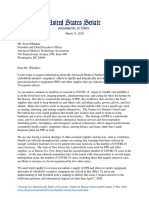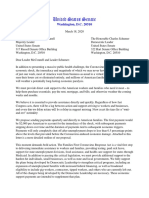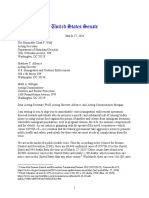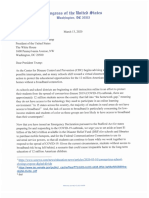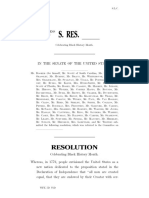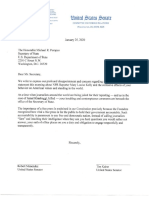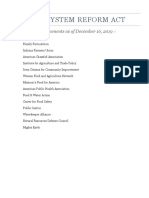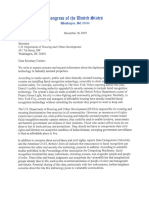Professional Documents
Culture Documents
Pay Transparency Letter 062818
Uploaded by
Senator Cory Booker0 ratings0% found this document useful (0 votes)
1K views4 pagesPay Transparency Letter 062818
Copyright
© © All Rights Reserved
Available Formats
PDF or read online from Scribd
Share this document
Did you find this document useful?
Is this content inappropriate?
Report this DocumentPay Transparency Letter 062818
Copyright:
© All Rights Reserved
Available Formats
Download as PDF or read online from Scribd
0 ratings0% found this document useful (0 votes)
1K views4 pagesPay Transparency Letter 062818
Uploaded by
Senator Cory BookerPay Transparency Letter 062818
Copyright:
© All Rights Reserved
Available Formats
Download as PDF or read online from Scribd
You are on page 1of 4
Wnited States Senate
WASHINGTON, DC 20510
June 28, 2018
‘The Honorable Jefferson Beauregard Sessions III _ The Honorable Joseph J. Simons
Attomney General Chair
U.S. Department of Justice Federal Trade Commission
950 Pennsylvania Avenue N.W. 600 Pennsylvania Avenue N.W,
Washington, D.C. 20530 Washington, D.C. 20580
Dear Attomey General Sessions and Chairman Simons:
In labor markets around the country, evidence points to a lack of competition, creating a growing
power imbalance between employers and workers. Too often, this lack of competition means that
American workers receive wages and compensation well below the economic value they create,
driving down the wellbeing of millions of working families and undermining the foundations of
our economy.
Lack of competition in labor markets—combined with other trends like increased market
concentration in many sectors,' declining geographic mobility for low- and middle-income
workers,? reduced union membership.’ and the erosion of workplace and labor standards such as
the minimum wage‘—has contributed to stagnant wages for many workers.> Since the late 1970s,
the bottom 90 percent of workers have seen a cumulative gain in real annual pay of just 21 percent.
For the median American worker, real hourly wages have increased by a total of only 14 percent
over the last four decades, and a worker in the bottom: 10th percentile has barely seen a raise at all.”
"Jason Furman, Beyond Antitrust: The Role of Competition Policy in Promoting Inclusive Growth, Sept. 16,2016,
bhups:/obamawhitchouse archives gov/stes/efaulifiles‘page/iles/20160916 searle_ conference competition furman_cca pdf
* Census Bureau, U.S. Department of Commerce, Americans Moving at Historically Low Rates, Census Bureau Reports, Nov.
16,2016, hps:/www.census gov newstoomipressrcleases/206/cb15-189.html.
» Megan Dunn & James Walker. Bureau of Labor Statistics, US. Department of Labor, Union Membership in the United States, Sep.
2016, hups:/www.bls gov'spotlight2016/union-membershp-in-he-anited-states/pdnion-membership tates pa.
“U.S. Department of Labor 7 Facts About the Minimum Wage, US, Department of Labor Blog, July 22,2016, htps:/blog dol gov
/2016107/22/7-facts-about-the-minimum-wage
S Benjamin Hattis, information Is Power: Fostering Labor Market Competition Through Transparent Wages, Brookings
Institution, Feb. 2018, hps:/www-brookings.edwwp-contenVuploads/2018"02/s_ 2272018 information is_ power harris. pp.pat
‘Elise Gould, The State of American Wages 2017, Economie Policy Institute, Mat. 1.2013, htps/ivww.ep.org/publication the
State-of-american-wages-201 7-wages-have-finally-recovered-fromhe-blow-of-the-preat-recession-but-are-still-growing-100-
slovwly-and-unequally
TM
One crucial advantage that employers hold over workers is asymmetric information about industry
pay: many employers have detailed data about wages in a particular market, while workers often
have little to no knowledge of how their wages compare with those of their co-workers or
colleagues at other companies. This lack of pay transparency makes it harder for workers to
negotiate for higher wages. It is also a significant contributing factor in perpetuating gender and
racial pay gaps, because it is harder for workers to find out that they are being underpaid in the
first place*
‘As you know, many employers participate in privately commissioned compensation surveys,
which provide detailed wage data organized by types of jobs and employers. Employers ostensibly
use this information to offer attractive compensation to their workers.? Compensation surveys are
widely used: in a recent study, 53 percent of firms reported having participated in a compensation
survey during the previous year.'°
Your agencies have long asserted a role for the federal government in supervising the exchange of
information through these surveys. While exchange of compensation information among
employers could form the basis for collusive behavior in violation of the Sherman Antitrust Act,
currently employers can share this information relatively freely thanks to the antitrust “safety
zone” policy implemented by the Department of Justice (DOJ) and the Federal Trade Commission
(FTC). The “safety zone” guidance, originally developed in 1996 for health care providers and
later extended to other industries," states that DOJ and the FTC generally will not challenge the
sharing of written compensation information among employers if it meets certain requirements
relating to who manages the survey, how old the reported information is, and how hard it is to
identify any individual employer’s compensation practices from the aggregated data.
DOJ and the FTC explained that this policy was expressly intended as a “careful balancing”
between, on the one hand, enabling employers to adjust wages based on market conditions and, on
the other, risking collusion by the same employers to set wages at an agreed-upon level." In fact,
the guidance specifically recognized that, in the absence of “appropriate safeguards,” “information
* Bg, Jelt Hayes, Private Sector Workers Lack Pay Transparency: Pay Secrecy May Reduce Women's Bargaining Power and
Contribute to Gender Wage Gap, Institute for Women's Policy Research, Dec. 20,2017, hips:/iwpr or/publicaionsprivate-
seetorspay-seerecy; of Valerie Wilson, Repeal of Pay Transparency Rule Wil Make It Easier To Disriminate Against Women
and People of Color, Economic Policy Insitute, Aug. 30,2017, hips:/hwww.ep.og/blog/repeal-of-paytransparency-rle-wil-
Imake-i-easier-(o
You might also like
- 20.4.3. FINAL FEMA Ventilator RequestDocument2 pages20.4.3. FINAL FEMA Ventilator RequestSenator Cory BookerNo ratings yet
- 20.3.31.FINAL AdvaMedDocument2 pages20.3.31.FINAL AdvaMedSenator Cory BookerNo ratings yet
- USPS Letter Re: COVID-19Document3 pagesUSPS Letter Re: COVID-19Senator Cory Booker80% (5)
- Letter To Amazon Re: CoronavirusDocument2 pagesLetter To Amazon Re: CoronavirusSenator Cory Booker100% (4)
- Booker, Menendez Letter To HHS Re: Coronavirus Supplemental FundingDocument1 pageBooker, Menendez Letter To HHS Re: Coronavirus Supplemental FundingSenator Cory BookerNo ratings yet
- Letter Re Cash Payments - 3.18.20Document3 pagesLetter Re Cash Payments - 3.18.20Senator Cory Booker100% (1)
- Booker Unemployment Insurance BillDocument9 pagesBooker Unemployment Insurance BillSenator Cory BookerNo ratings yet
- 3.27.20 Booker Letter To Dhs Ice and CBP Final SignedDocument5 pages3.27.20 Booker Letter To Dhs Ice and CBP Final SignedSenator Cory BookerNo ratings yet
- 20.3.21. FINAL - PPE + Supplies Letter To Trump + AzarDocument2 pages20.3.21. FINAL - PPE + Supplies Letter To Trump + AzarSenator Cory Booker100% (1)
- MSI Funding LetterDocument3 pagesMSI Funding LetterSenator Cory BookerNo ratings yet
- CB RM Airport Screenings Letter To Pence 3.10.20Document3 pagesCB RM Airport Screenings Letter To Pence 3.10.20Senator Cory Booker100% (1)
- 19.12.06 - University HospitalDocument1 page19.12.06 - University HospitalSenator Cory BookerNo ratings yet
- 3.18.20 - Senator Booker Letter To BOP DirectorDocument2 pages3.18.20 - Senator Booker Letter To BOP DirectorSenator Cory BookerNo ratings yet
- Care For COVID-19 ActDocument6 pagesCare For COVID-19 ActSenator Cory BookerNo ratings yet
- Mobile Hotspot Letter To PresidentDocument2 pagesMobile Hotspot Letter To PresidentSenator Cory BookerNo ratings yet
- S.Res.516: 2020 Black History Month ResolutionDocument5 pagesS.Res.516: 2020 Black History Month ResolutionSenator Cory BookerNo ratings yet
- Support Letter - Decentralized Wastewater Grant Act - 2.11.20Document1 pageSupport Letter - Decentralized Wastewater Grant Act - 2.11.20Senator Cory BookerNo ratings yet
- 20.3.3. Letter To Leadership On Coronavirus FundingDocument2 pages20.3.3. Letter To Leadership On Coronavirus FundingSenator Cory BookerNo ratings yet
- 19.04.12-US Army Corps Cheesequake CreekDocument2 pages19.04.12-US Army Corps Cheesequake CreekSenator Cory BookerNo ratings yet
- 1.1.0.20 LTR To POTUS Re Protection of Embassy SecurityDocument2 pages1.1.0.20 LTR To POTUS Re Protection of Embassy SecuritySenator Cory BookerNo ratings yet
- Maternal Health Day Awareness ResolutionDocument5 pagesMaternal Health Day Awareness ResolutionSenator Cory Booker100% (1)
- Senate Resolution Supporting Farmers Bill of RightsDocument8 pagesSenate Resolution Supporting Farmers Bill of RightsSenator Cory BookerNo ratings yet
- 12.18 Immigration Hotline Letter To DHS ICEDocument4 pages12.18 Immigration Hotline Letter To DHS ICESenator Cory BookerNo ratings yet
- SFRC Letter 1.25.20 On Mary Louise KellyDocument2 pagesSFRC Letter 1.25.20 On Mary Louise KellySenator Cory Booker100% (1)
- Farm System Reform Act EndorsementsDocument1 pageFarm System Reform Act EndorsementsSenator Cory BookerNo ratings yet
- Farm System Reform Act Endorsements 12 16 PDFDocument1 pageFarm System Reform Act Endorsements 12 16 PDFSenator Cory BookerNo ratings yet
- Booker Wyden-Led Letter To HUD RE Facial Recognition TechnologiesDocument3 pagesBooker Wyden-Led Letter To HUD RE Facial Recognition TechnologiesSenator Cory BookerNo ratings yet
- 12.17.19 Letter On Tongass Roadless Native RightsDocument3 pages12.17.19 Letter On Tongass Roadless Native RightsSenator Cory BookerNo ratings yet
- Farm System Reform ActDocument35 pagesFarm System Reform ActSenator Cory Booker100% (1)
- Section by Section Summary Farm System Reform ActDocument3 pagesSection by Section Summary Farm System Reform ActSenator Cory BookerNo ratings yet
- Shoe Dog: A Memoir by the Creator of NikeFrom EverandShoe Dog: A Memoir by the Creator of NikeRating: 4.5 out of 5 stars4.5/5 (537)
- Never Split the Difference: Negotiating As If Your Life Depended On ItFrom EverandNever Split the Difference: Negotiating As If Your Life Depended On ItRating: 4.5 out of 5 stars4.5/5 (838)
- Elon Musk: Tesla, SpaceX, and the Quest for a Fantastic FutureFrom EverandElon Musk: Tesla, SpaceX, and the Quest for a Fantastic FutureRating: 4.5 out of 5 stars4.5/5 (474)
- The Subtle Art of Not Giving a F*ck: A Counterintuitive Approach to Living a Good LifeFrom EverandThe Subtle Art of Not Giving a F*ck: A Counterintuitive Approach to Living a Good LifeRating: 4 out of 5 stars4/5 (5783)
- Grit: The Power of Passion and PerseveranceFrom EverandGrit: The Power of Passion and PerseveranceRating: 4 out of 5 stars4/5 (587)
- Hidden Figures: The American Dream and the Untold Story of the Black Women Mathematicians Who Helped Win the Space RaceFrom EverandHidden Figures: The American Dream and the Untold Story of the Black Women Mathematicians Who Helped Win the Space RaceRating: 4 out of 5 stars4/5 (890)
- The Yellow House: A Memoir (2019 National Book Award Winner)From EverandThe Yellow House: A Memoir (2019 National Book Award Winner)Rating: 4 out of 5 stars4/5 (98)
- On Fire: The (Burning) Case for a Green New DealFrom EverandOn Fire: The (Burning) Case for a Green New DealRating: 4 out of 5 stars4/5 (72)
- The Little Book of Hygge: Danish Secrets to Happy LivingFrom EverandThe Little Book of Hygge: Danish Secrets to Happy LivingRating: 3.5 out of 5 stars3.5/5 (399)
- A Heartbreaking Work Of Staggering Genius: A Memoir Based on a True StoryFrom EverandA Heartbreaking Work Of Staggering Genius: A Memoir Based on a True StoryRating: 3.5 out of 5 stars3.5/5 (231)
- Team of Rivals: The Political Genius of Abraham LincolnFrom EverandTeam of Rivals: The Political Genius of Abraham LincolnRating: 4.5 out of 5 stars4.5/5 (234)
- Devil in the Grove: Thurgood Marshall, the Groveland Boys, and the Dawn of a New AmericaFrom EverandDevil in the Grove: Thurgood Marshall, the Groveland Boys, and the Dawn of a New AmericaRating: 4.5 out of 5 stars4.5/5 (265)
- The Hard Thing About Hard Things: Building a Business When There Are No Easy AnswersFrom EverandThe Hard Thing About Hard Things: Building a Business When There Are No Easy AnswersRating: 4.5 out of 5 stars4.5/5 (344)
- The Emperor of All Maladies: A Biography of CancerFrom EverandThe Emperor of All Maladies: A Biography of CancerRating: 4.5 out of 5 stars4.5/5 (271)
- The World Is Flat 3.0: A Brief History of the Twenty-first CenturyFrom EverandThe World Is Flat 3.0: A Brief History of the Twenty-first CenturyRating: 3.5 out of 5 stars3.5/5 (2219)
- The Unwinding: An Inner History of the New AmericaFrom EverandThe Unwinding: An Inner History of the New AmericaRating: 4 out of 5 stars4/5 (45)
- The Gifts of Imperfection: Let Go of Who You Think You're Supposed to Be and Embrace Who You AreFrom EverandThe Gifts of Imperfection: Let Go of Who You Think You're Supposed to Be and Embrace Who You AreRating: 4 out of 5 stars4/5 (1090)
- The Sympathizer: A Novel (Pulitzer Prize for Fiction)From EverandThe Sympathizer: A Novel (Pulitzer Prize for Fiction)Rating: 4.5 out of 5 stars4.5/5 (119)
- Her Body and Other Parties: StoriesFrom EverandHer Body and Other Parties: StoriesRating: 4 out of 5 stars4/5 (821)

